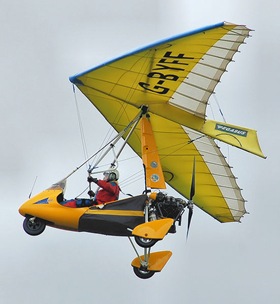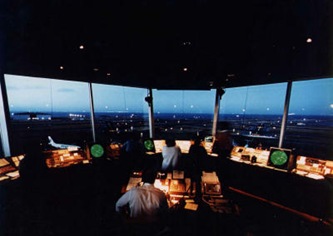- Try to stay in the middle of the air.
- Do not go near the edges of it.
- The edges of the air can be recognized by the appearance of ground, buildings, sea, trees and interstellar space. It is much more difficult to fly there.
How to master short field landings
Jason Schappert, the blogger behind the MzeroA site, has recently written a post where he compiled his three videos about short field landings. He also noted that in his most recent video, he took one of his students over Cedar Key for some short field landing practice (and of course, a bite to eat). This video contains mostly raw footage of traffic patterns plus short field landing practice.
Hence and if you think that you will need to do a short field landing at some point as a pilot, all three of Jason’s videos are well worth watching.
Microlights & LSAs: Now everyone can fly
Bob H., an ultralight aviation fan who writes about ultralights and microlights, has written a great post for the Planegrazy blog about ultralights/microlights and light sport aircraft (LSA) that is well worth reading by a would-be pilot who has concerns about the high costs associated with learning how to fly and flying in general. Bob began his post by noting that so-called ultralight experimental aircraft have different names in different regions. Specifically, they tend to be known as ultralights or light sport aircraft (LSAs) in the USA and as microlights in Europe.
However, Bob added that it doesn’t really matter where you are located, what you call these aircraft and just what the exact specifications are because these “toy” aircraft offer the following key advantages:
- Regulations are relaxed. In fact, they are usually much more relaxed than the rules and regulations for flying either light aircraft or private jets.
- Prices are lower. Some ultralight/microlight aircraft prices start in the US$20,000 range for a brand new one and can be even cheaper for a second hand aircraft.
- Fuel consumption is lower. More importantly, most ultralight/microlight aircraft will use regular car gas and consume only 3 to 5 gallons per hour. In contrast, light aircraft fuel consumption will start at 8 gallons for a 4-seater.
- Training is easier. Less flying hours will be required. Hence, getting a sport pilot or an experimental pilot license will be easier and cheaper.
- Storage or hangar fees are lower. Since the aircraft are smaller, associated airport costs will be lower. Moreover, an ultralight/microlight trike can even be kept in your garage.
Bob went on to write about some specific types of aircraft such as fixed wing airplanes, flex wing aircraft, ultralight helicopter, Amphibians, floats, seaplanes and powered paragliders.
Finally, Bob ended his post by noting that if the cost of flying ultralights/microlights and LSAs are still to high, you could always consider joining a flying club. Moreover, an ultralight/microlight can be rented for a day or two – so long as you have a license to fly it. Hence and if you really want to fly, there is nothing to stop you.
What to do if you suffer a break in your flight training
If you are a would-be pilot who has suffered a break in your flight training, then the answers to a recent question posted by Tom on the Ask a Flight Instructor site is well worth reading. Tom began by noting that he solo’d in May 2010 and that he also had his stage one check in June 2010 while his last flight was July 2010. He also added that he did have some issues with his CFI who has since left where he was training but he also added that:
The manager is great there and has always worked with me. Finding another CFI shouldn’t be an issue. My father was ill so I stepped away from training. My dad passed away March of 2011. It still may be a while before I can get back to training in the air. I do read training material and watch the Cessna King training dvd’s. I do know I want to get ground school training and pass my written before taking to the air. Book work has been harder than flying for me.
Commenter Micah responded by asking Tom if his flight school would let him backseat while others fly. He also added that this is an underappreciated way to learn plus its a great way to meet other pilots and instructors at the flight school. Moreover, it’s free.
Pete Kemble then told his story of having a couple of breaks in his flight training. Eventually, he found the time to fly 13 years after his last break and he noted that his major mistake was not continuing his flight training outside of the aircraft. Hence, he suggested that you keep yourself “current” by:
…digesting everything you can aviation related. Read through all the FAA texts online. Join AOPA and you’ll get a free subscription to Flight Training (fantastic bathroom reading
). There’re plenty of free online resources as well (this site for one) that will help keep your mind in aviation as well.
Finally, commenter James MacGregor CFI asked Tom just why his CFI left as when he was doing his training, he had asked around to find out who the best CFIs were. He then noted that if you had a good experience with your CFI, he or she might be able to work with you outside of the flight school – saving you both time and some headaches. Moreover, James also added that most CFIs “worth their salt” will be able to locate an aircraft that they can use to teach you in outside of a flight school.
Hence and if you are a would-be pilot like Tom who has experienced a break or disruption in your flight training, the entire thread is well worth reading.
Why do air traffic controllers fall asleep on the job?
We have recently written about the rash of sleeping air traffic controller incidents in the USA. Hence, its well worth mentioning that Langhorne Bond, an FAA administrator from 1977 to 1981, and Robert W. Poole Jr., a director of transportation policy at the Reason Foundation, have co-written an interesting opinion piece for the Wall Street Journal about why they believe air traffic controllers in the USA are falling asleep when they in fact have the last word on their work schedules.
The pair wrote that the most popular air traffic controller shift is called 2-2-1 where air traffic controllers work two swing shifts, then two day shifts and finally one midnight shift. The second day shifts will end at 2 pm while the subsequent midnight shift will begin later in the evening at 10 pm – a mere eight hours later. This type of schedule obviously disrupts circadian rhythms and creates fatigue for those on the midnight shift. Moreover, the authors noted that:
Within air traffic circles, this problem is so well-known that 2-2-1 has long been called "the rattler," since it can come back and bite the controller, degrading his performance. But controllers and their union have fought to keep 2-2-1 because it gives them a three-day weekend afterwards.
Nevertheless, the National Transportation Safety Board (NTSB) has called for abolishing 2-2-1 as far back as an April 2007 report while the inspector general for the Department of Transportation wants a 10-hour minimum between shifts plus 16 hours after any midnight shift.
The authors then pointed out that another major cause of fatigue on midnight shifts in the USA are the black backgrounds on controller display screens. This means that a dark room is needed for better visibility but this also induces drowsiness on late night shifts.
Hence, it is now common international practice outside of the USA to have light gray background screen displays since these types of screens can be used in high-light environments. However and in the USA, this trend has been all but ignored.
Moreover and over the past 15 years, nearly every developed country (except for the US) has separated air safety regulation from the provision of air traffic control services to be consistent with the policies set forth by the International Civil Aviation Organization. By doing this, there is an arm’s-length safety regulation of air traffic control itself.
Hence, the authors ended their piece by calling for this separation and by stating that the current controller-fatigue flap is a wake-up call to do so.

